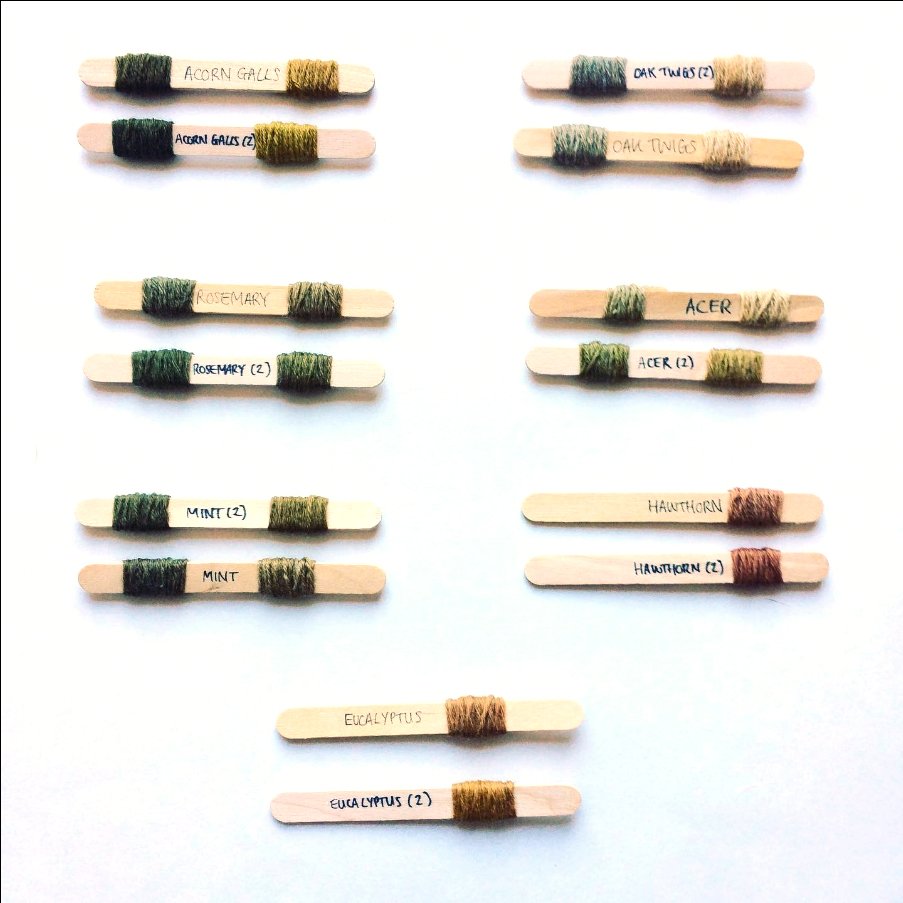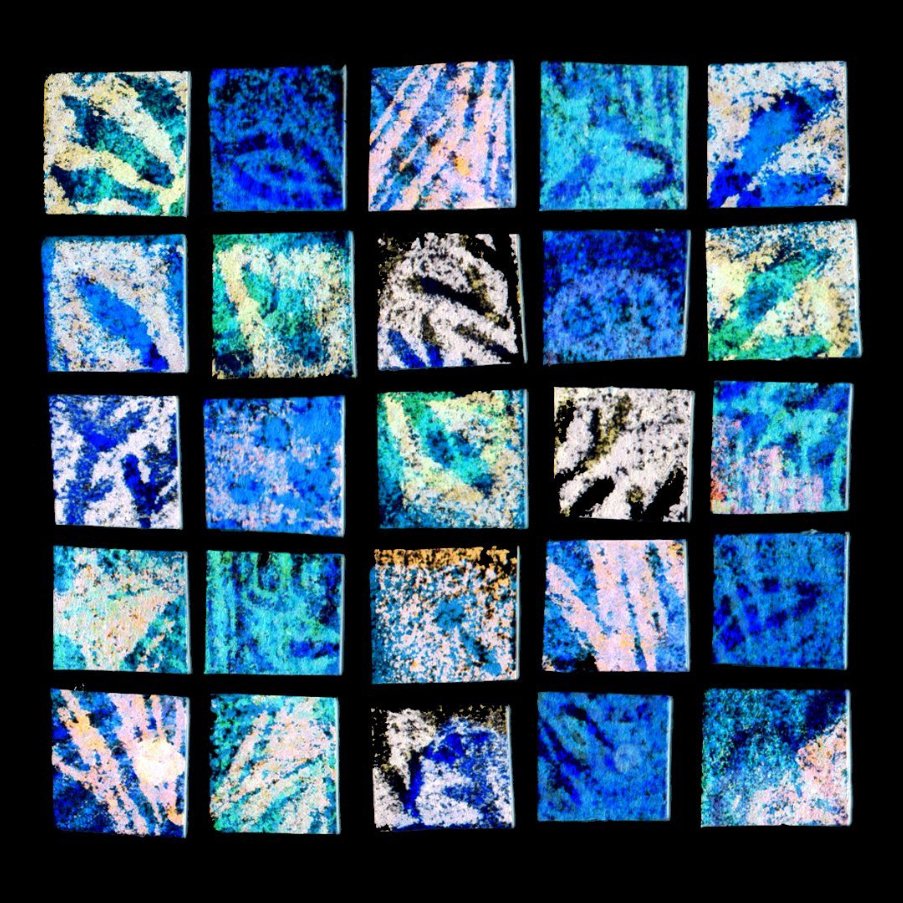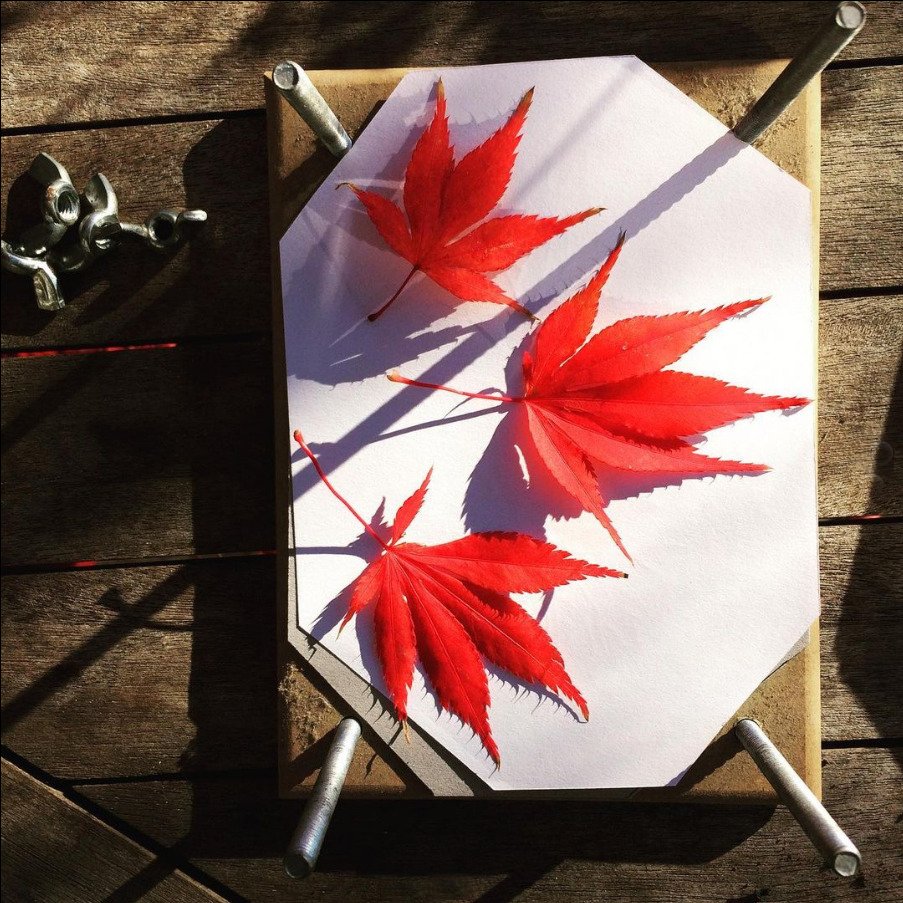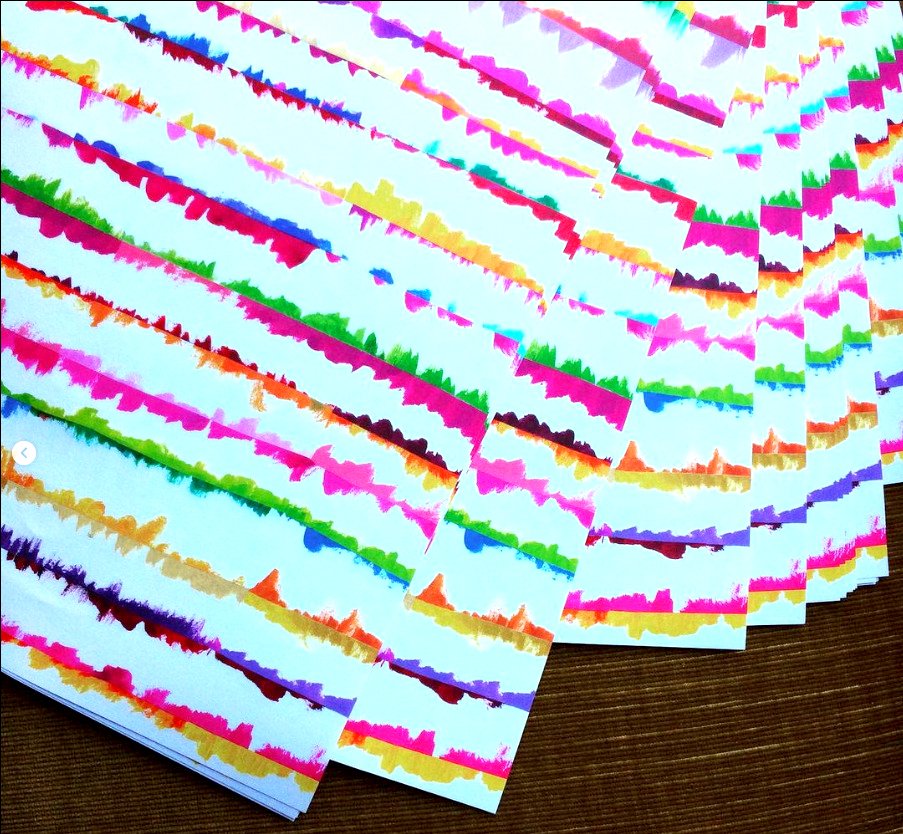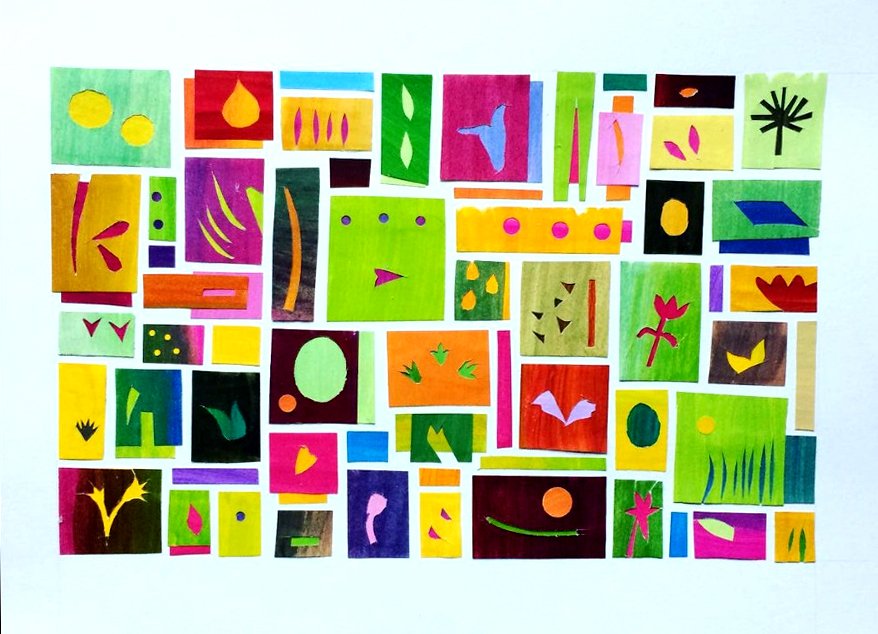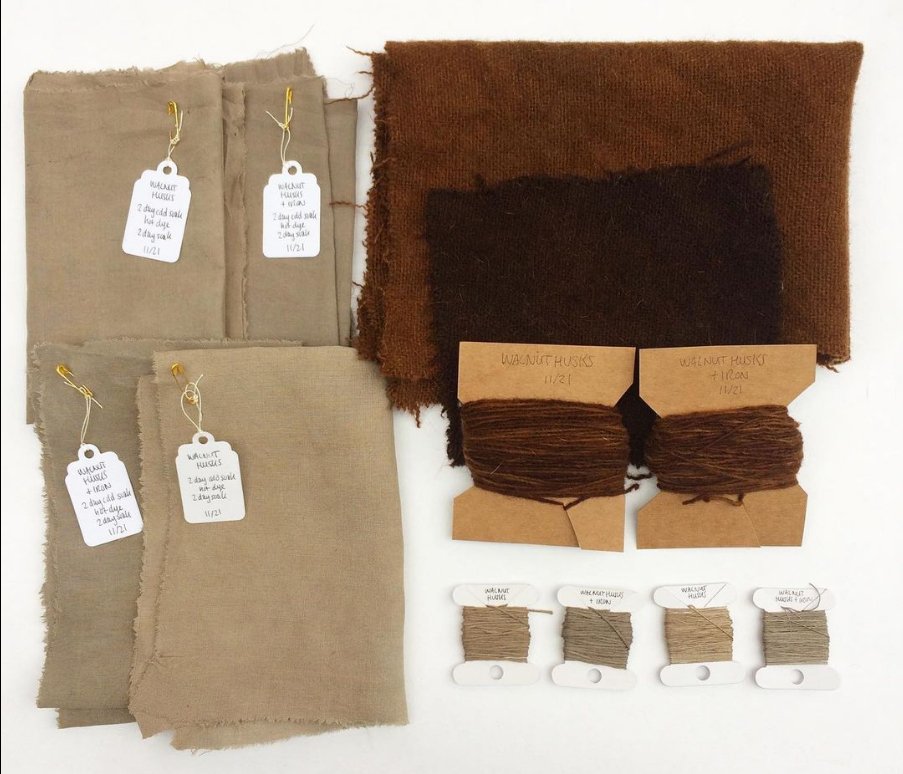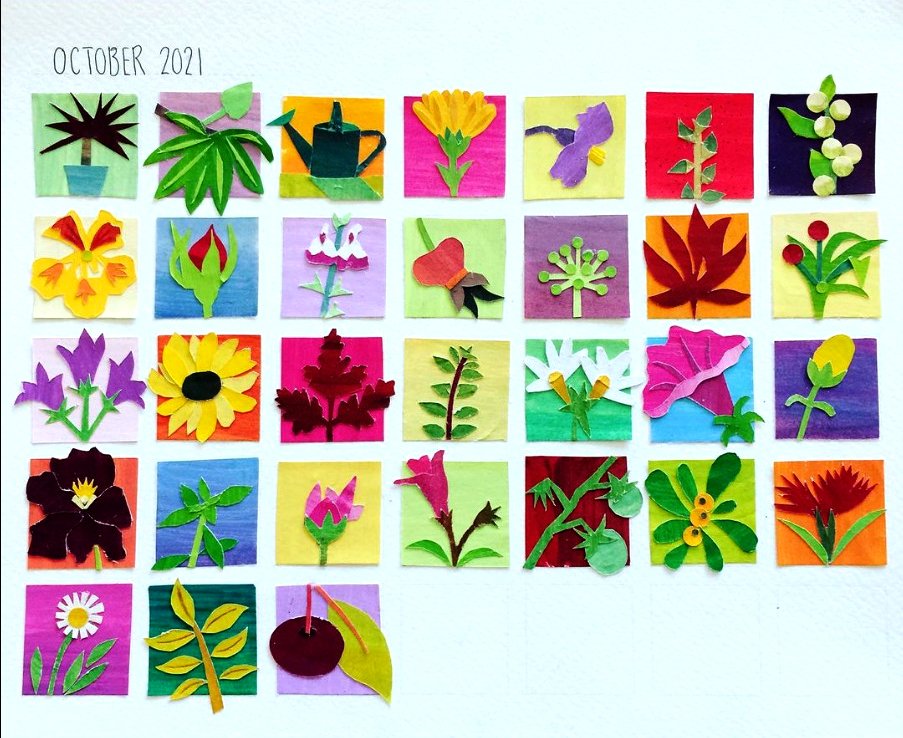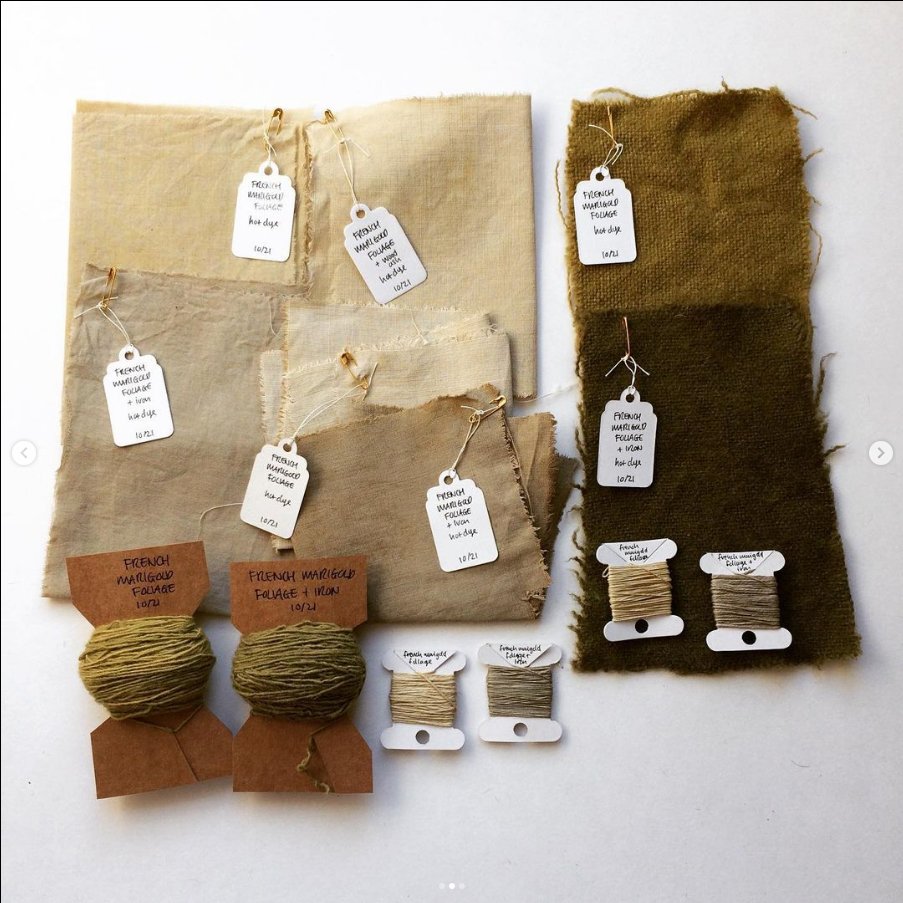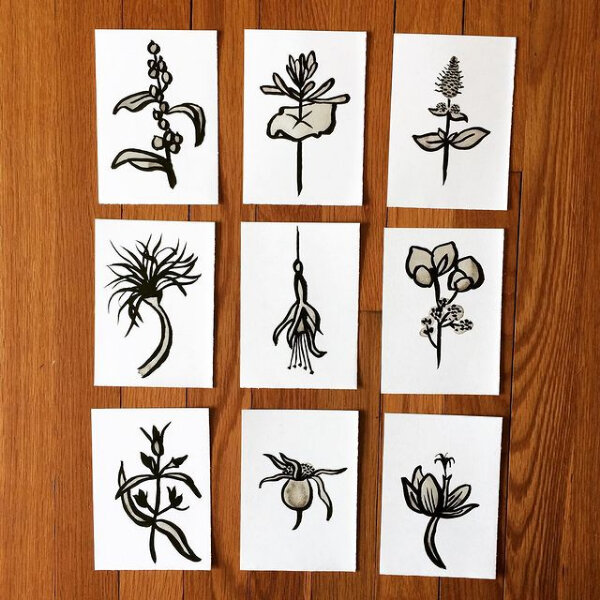The opposite of instant gratification... here are the results of the lightfastness test I set up last January for yarn I dyed in autumn 2020. The top lollipop stick of each pair has been sat on my sunny studio window sill for a year. The bottom sticks are the same yarn that’s been stored in a dark box during that time. The first photo shows the more fugitive colours - sloes and red cabbage are particularly unstable. The second photo shows dyes from trees and herbs - I’m surprised how little those colours have faded in the sunlight...
Week fifty two
And so ends the Garden Residency 2021!
One final collage of offcuts for the year
My small article in the latest issue of Printmaking Today
Penultimate dye experiment of the year – Yarrow (achillea)
December’s daily drawings - back-drawn monoprints with natural ink
And so ends my 2021 Garden Residency... it’s been a diversion, an excuse to experiment, some much needed structure, and license to play. A creative sabbatical. Accompanied throughout by my trusty studio assistant, Otto (a Vizsla of senior years).
One final collage of monoprinting offcuts before the year came to a close. If in doubt, cut out circles and arrange them in a grid. Always a useful creative un-blocker.
My last two dye experiments of the year are out of the dyepot... that makes 55 in total. Shown here is Yarrow (achillea) and I have Teasel drying at the moment. To be honest the colour palettes are very similar. A rather unexceptional end to a year of colour creation, but I’m looking forward to using some of the dyed fabric, yarn and thread from my dye experiments in new work next year.
In a piece of perfect timing, I received some exciting post on the penultimate day of this year-long project. I’m thrilled to bits to have a small piece on my garden residency in the latest Printmaking Today magazine. Many thanks to editor Leonie Bradley for including me in this issue.
My final month of daily drawings... 31 days of (rather splodgy) back-drawn monoprints coloured with natural ink (mostly marigold, black dahlia and oak twigs). As with all of the other eleven sheets, it’s interesting to see the overall effect as they accumulate through the month, rather than focusing on one drawing in particular.
I’m pleased to have completed my year-long challenge of a drawing a day, and I think I may have unintentionally made it into a habit (although I may reduce it to just weekdays as this is easier to build into my work schedule). Here’s to more drawing in 2022!
Amongst many other things, this Garden Residency has been a useful exercise in maintaining a weekly blog entry – based on my many Instagram posts throughout the year. I’ve really appreciated all the words of support, encouragement and feedback – it’s been a good way of feeling more connected during an otherwise isolated year.
I now need to finish recording my work in my journal, and take some time to consolidate and reflect, before working out my next steps. In the meantime, wishing everyone a happy and healthy new year... x
Week fifty one
Pressed (and nibbled) Geranium leaves
Sunflower dye results
My Christmas card this year
I’ve uncovered some weird and wonderful geranium leaves out of the flowerpress. Not sure what had been nibbling them to create such impressive doilification (is that a word?!) I’ll store these to make some cyanotypes next year when the sun makes a welcome return.
A soft range of colours from dyeing sunflower heads. More like the seeds than the flowers. These were a pretty standard variety, but I also attempted to grow black Hopi sunflowers (meant to be excellent for dyeing) this year after @sixhq kindly sent me some seeds back in the Spring. Even in pots on gravel, they proved irresistible to the slugs, but I managed to at least grow enough to collect more seed to try again next year.
This is my Christmas card this year – a (slightly doctored) cyanotype of hydrangea petal skeletons from my garden. Made in summer but it felt suitably wintery. Wishing everyone reading this a very relaxing and festive season wherever you are (and whatever restrictions you may be facing).
Week fifty
A leaf rubbing stitched with dyed linen thread
The four stages of the dye process (see below for details)
Coreopsis dye results
Playing around with my small stash of pressed leaves. I made a rubbing of a passionflower leaf, coloured it with an ink stamp pad, then cut it out and stitched it onto some Somerset paper using linen thread (dyed with carrot tops). Many of the leaves are too fragile to incorporate directly, but making rubbings seems to be a good way of reproducing them... more experiments needed!
I’ve been trying to clear some space in the freezer before Christmas, so there’s a flurry of dyeing activity, mostly with frozen flowerheads. I realised the different pans sat on my decking illustrated the various stages of the dye process:
1. Dried teasels soaking in water ready to be boiled into dye
2. Yarrow just boiled up, waiting to cool down before being strained
3. Strained sunflower dye with fabric, thread and yarn, cold soaking for a day before being heated up
4. Spent coreopsis dyebath, ready to be boiled down into ink
Finally, a welcome pop of colour on a grey December day – the results of dyeing with coreopsis. Gorgeous yellow flowers, deadheaded over the summer (and stashed in my freezer). They make a lovely range of oranges (turning brown with iron oxide). Something quite magical about creating colour in winter from flowers collected in sunnier times...
Week forty nine
Paper stencils from November’s polyprints
Collage of chopped up test sheets from polyprints
Another polyprint test sheet collage
And an inverse image in Photoshop
Dye results from iris tubers
I kept the paper stencils cut for November’s polyprints. I really like the chunky quality of the shapes and would like to use this as a starting point for new work. Maybe a woodcut? Or an embroidery? Or even another collage?
Using up more waste material… I chopped up the test sheets from last month’s polyprints... interesting colour combinations and texture. I inversed one of the scans in Photoshop and I was fascinated by how different it looks when the colour palette is altered.
I’d read that dye could be made from iris root (tubers)... I was moving some irises from the front garden, so decided to test it out. Not quite the colour punch I was hoping for, but some pleasant-enough teddy bear browns in the yarn and woollen blanket (looks a bit more ochre in this photo than it does in real life).
Week forty six
Pressing acer leaves to preserve some of the colour
First attempt at hapazome printing
Another offcuts collage
A batch of printed wrapping paper
Black dahlia flowers – dye results
Trying to capture some of the amazing autumn colour outside my back door by pressing acer leaves (already hardly any left on the tree by the time I type this).
I made a first attempt at hapazome - the Japanese technique of creating prints from plant material by hammering with a mallet. Not overly successful – there was a lot of squashy splodges not shown here – but I could identify what has potential… hydrangea petals and leaves of acer, herb Robert and nasturtium...
Couldn’t quite bin what was left of the brush cleanig gouache strips, so I made another collage of the tiny offcuts (getting smaller!) I also received some wrapping paper back from the printers featuring a repeat pattern of my original collage of offcuts. Lovely job by printed.com
I grew dahlias for the first time this year... lost a few early on to ravenous molluscs, but the gorgeous black blooms made an appearance in July and have only just stopped flowering last week. I’ve been saving deadheaded flowers in the freezer and made this dye batch with them last week. A strong range of browns. Next year I’ll freeze them in an airtight container though... the musty smell taints ice - not a welcome addition to my G&T!
Week forty five
Initial collage play
A garden collage - leftovers of leftovers
Results of dyeing with walnut husks
Walnut husks soaking in boiling water prior to making a dye bath
It seemed a shame to throw away the offcuts from the gouache brush cleaning strips used for last month’s daily collages, so I started playing around with them. Leftovers of leftovers. The final collage I made felt like a small paper jigsaw. I really like the random shapes and incidental colour combinations that come from working like this.
I finally got the chance to dye with walnut husks after spotting a tree on my morning dog walk. A really impressive depth of colour on the yarn and woollen blanket, although hardly any shift in colour at all with iron oxide. The colour started coming out of the husks the moment they were covered with boiling water. You definitely need to wear gloves with this dye bath, or you’ll end up with yellow smoker’s fingers (speaking from experience). Looking forward to making ink with what’s left of the dye...
Week forty four
October’s ‘daily drawings’ - collage
Dye results with French Marigold flowerheads
Dye results with French Marigold foliage
French Marigold ink
October’s daily drawing challenge - 31 days of collage. The collage material was the cut-up sheets of paper I cleaned my brushes on for last month’s gouache daily drawings. So a similar colour palette, but they feel quite different. This month was definitely the most fun so far this year.
French marigolds - an astonishing amount of colour extraction. This shows the results of hot and cold dye baths of the flower heads, and then also the foliage, which I boiled up separately (lovely smell). Big thanks to my very kind neighbour Norman who donated these magic plants for dye experimentation.
I also made a tiny batch of French Marigold ink – bottled sunshine as the winter nights draw in!
Week forty two
A bramble colour palette
Bramble leaves dye results
Bramble stems dye results
Pot Marigold flower dye results
Early morning shadows on the ‘daily drawing’ collages
A week of dye results…
First up is a comparison of yarn dyed with bramble – on the left are yarns dyed with brown stems in February; in the middle are yarns dyed with mostly green stems this month; and on the right are yarns dyed with bramble leaves, also this month. The differences are surprising all from the same plant in the garden. I like how they form a very harmonious colour palette.
The latest bramble dye results in full show a comparison between the leaves and the stems. A bit more subtle than the differences with the yarn, but still a useful lesson in the importance of separating a plant into different dye pots.
More dye results from pot marigolds, grown from seed this year. The flowers were dead-headed and collected in the freezer over a number of months. They were mixed colours so perhaps the results were not as strong as they would have been with French marigolds. A good buttery range all the same.
Finally, my ‘daily drawing’ this month has been collage (using the sheets of gouache colour from cleaning my brushes for last month’s daily drawing). Dramatic shadows from the early morning sunshine in my studio make them look a lot more 3-dimensional.
Week forty
I started the week working on another saved-from-the-bin piece... offcuts from my daily drawing gouache brush cleaning colour swatches last month made into a collage, then turned into a repeat pattern in photoshop. I’ve scaled this up to A2 so I can get some sheets of wrapping paper printed.
Whilst I was in a bright colour mood, I started to introduce colour to my hollyhock rubber stamp repeat pattern. This also may work as wrapping paper.
Interesting dye results from black poppies - these have self-seeded all over my front garden, and I gathered the spent petals earlier in the summer and froze them. They make a nice range of soft grey-greens similar to black hellebore petals.
Finally, some hidden hieroglyphics revealed themselves as I went to clean out a dye pot one morning... my favourite patterns and symbols are accidental ones.
Week thirty eight
Garden residency on tour - drawings from a garden in Norfolk
Buddleia dye results
Colourful brush cleaning from my September daily drawings (gouache this month)
My garden residency was on tour last week as I de-camped to Norfolk for the week. A new garden with lots of different plants and flowers to draw. So lovely to have a change of scene, and a long overdue chance to get reacquainted with the sea...
I dyed some cotton lawn with buddleia flowers last summer, but I was keen to see how the colour would turn out across a wider range of materials this year. It was worth the wait... some lovely vibrant yellows and strong greys. The two yellow yarns and woollen blanket swatches show the difference between a cold and hot dye bath. More than a hint of bumblebee about this colour palette... 🐝
Cleaning my brushes after my daily drawings (gouache this month) I’ve been building up vibrant stripes of colour - an appropriate colour palette for a gloriously sunny week in Norfolk. I’m hoping to use these painted swatches as collage material for next month’s daily drawings.
Week thirty seven
I made a tiny snake book of roses, made from an insert from a David Austin catalogue (rescued from the recycling bin). The grid of photos was printed on both sides of the paper, so it opens in both directions.
I needed assistance with labelling my latest dye experiment. It’s an unusual mix of colours - pinky brown and grey on cotton and linen; ochre and very dark green on wool and silk. I thought the plant in question was called Toadflax, but after some light googling to check this, I realised I’ve been using the wrong name. Thanks to the expertise of some of my followers on Instagram, I now know that this needs to be labelled ‘Yellow Loosestrife’.
Finally this week, I made another collage with offcuts from the rubber stamp test sheet from last month’s daily drawings. It reminded me of watercolour, so I reproduced it in paint. Not that excited by the end result, but I really enjoyed the process. Bespoke colouring-in... an exercise in slowing down and not thinking too hard about what you’re creating.
Week thirty four
A small concertina book of seedhead drawings using black hellebore ink and backdrawn monoprints
Quick collage of post-it note masks used in making rubber stamp prints
Dye results from Rowan… leaves on the left and berries on the right
I’ve made my plant form drawings into a small concertina book - black hellebore ink with backdrawn paper monoprints on somerset paper. I like the combination of natural ink and monoprints and would definitely like to explore this combination further.
An unusual pop of colour in my garden residency... I’ve been carving a daily rubber stamp through August, and I’ve been masking areas off with post-it notes. I was about to clear the paper masks into the bin when I decided to stick them on a bright piece of paper instead. Instant collage gratification.
A surprising set of dye results from Rowan. The bright berries (photographed a couple of weeks ago) only gave out any bold colour onto silk and wool (see browns on the right hand photo) but the leaves - which I only boiled up as an afterthought as I only had a few - gave a wide range of ochres and browns across all the materials. Shows it’s worth splitting up plant material to get a wider range of colour - a useful lesson!
Week thirty three
I finished my small embroidery based on drawings of viburnum flowerheads. Split stitch and French knots on linen. The third ‘tree’ is perhaps a bit light in tone, but it’s not an exact art when using naturally dyed thread. The linen was dyed with hypericum leaves (from under the viburnum tree in the garden) and the threads were dyed with sloes, bramble branches and Swiss cheese plant leaves. The first two from the garden, the last one from the house.
With a similar colour palette, I’ve been refining my plant form drawings… using India ink and teasel ink. I think these would work well in a small concertina book - all grids seem to point back to folded books at some point!
Common sorrel collected from a local field was one of the first plants I dyed with last summer, but I only dyed cotton lawn then, and had to wait another 12 months for the flowerheads to die back ready to be picked again. It was worth the wait - it’s a lovely, rich range of terracottas and browns, and the colour seems to take well across all materials. The woollen blanket has ended up the exact colour of my dog, so I may dye a larger piece as I like the idea of embroidering a line drawing of him.
Week thirty two
Rowan berries ready for the dye pot
First set of plant form ink drawings with a Chinese brush
Second set of plant form ink drawings with a Chinese brush
Back of an envelope simplifying of plant form drawings
August is a very busy month with work, so time is limited for the garden residency right now. I’ve been dyeing with common sorrel this week (results to be photographed next week) and have been preparing rowan berries and leaves for the dye pot. I was struck by the vibrant colour of the berries in the pan, especially alongside a pink salvia in a pot on the table at the same time. Eye popping!
Following an excellent online Domestika course with Jesús Cisneros, I have been making drawings of plant forms from the garden using ink and a Chinese brush. It’s a good technique for simplifying shapes, and I took these initial drawings to work out (on the back of an envelope) how they could be simplified further still. These two colour drawings could be taken in a few different directions next - Monoprints? Embroidery? Rubber stamps? It’s good to have options.
Week thirty one
Natural ink sample sheet - finally full up!
Teasel dye results
Rubber stamps based on pattern of shaows on a garden chair
Really pleased with the dye results from the teasels… a blue/grey on the cotton and linen fabric and thread, and a khaki green on the yarn and woollen blanket. I’d be interested to try dyeing with them again, but maybe soaked for longer and more chopped up to see if I can get a stronger blue. I boiled the dye down to make an ink - the first attempt was a disaster as it boiled dry and then exploded all over a white wall (note to self: it stains!) But the second attempt worksed well and gave an unusual grey ink – a welcome addition to complete my sample sheet of natural ink samples.
I carved a rubber stamp based on a photo I took of shadows on a garden chair… it worked better when overprinted in a contrasting colour, or cut up into a grid collage.
A bit of a hiatus in the dyeing experiments as I need to mordant more fabric (my least favourite part of the dye process as it takes so long).
Week thirty
Daily drawings for July – wax pastels
Teasels soaking ready to make into a dye
Scans of hydrangea petal skeletons collected from the garden earlier in the year
The first tree in my embroidery based on drawings of Viburnum flowerbuds
July comes to a close, and my sheet of daily drawings for the month is completed. I chose wax pastels as I haven’t used them very much before. With hindsight, this was a bit of a chunky medium to use for such a small scale… but this made me simplify my style and concentrate on bold shapes. Some worked better than others, but I am pleased with how coherent they look as a collection of drawings - I think it helps filling each square instea of leaving white space around the drawing. Next month - rubber stamps (back in my comfort zone).
Teasels I’ve grown from seed last year have turned into giants at the bottom of the garden (some around 3m tall!) They looked rather splendid and statuesques for a short period of time, but then after heavy rain and winds most of them have collapsed. So, in the spirit of ‘waste not want not’, I chopped up some of the flower heads from the fallen plants. An initial soak in hot water has already yielded an interesting bluey-green colour, so I have high hopes for the dye and ink that can be made from these casualties.
I finally got around to scanning some hydrangea petal skeletons I collected from the garden back in early spring. I was fascinated to see how much they looked like trees (or coral as suggested on Instagram). I’ve printed these out onto acetate and hope to use them to make a cyanotype when the sunshine makes a return visit. On the same them of ‘things that aren’t trees but look like they are’ I started my embroidery based upon drawings of Viburnum flowerheads I made last month. The linen is dyed with Hypericum and the thread is dyed with Sloes (+ iron oxide) - both from the garden. This is unusually neat stitching for me - I realised that wearing two pairs of specs allowed me to see detail much better!
Week twenty nine
Cyanotype of Corydalis leaf
Cyanotypes of acer, passion flower and cosmos leaves
Early morning sketching in the front garden
Hand drawn map of the veg patch
The wide range of colour from Herb-robert
In the sprit of using this year of my ‘garden residency’ to try new techniques, I’ve dipped my toe in the chemical waters of cyanotypes. Making the most of the recent heatwave in the UK, I made some solar prints with leaves I’ve recently liberated from my flower press. Results were mixed, but it was an interesting introduction to the process, and I’d definitely like to try more.
Two types of ink drawing this week… one using a bamboo dip pen sat in my front garden very early on a sunday morning, and the other a stylised map of my veg patch (minus weeds and slug damage).
This week’s dye results were from the excellently named Herb-robert – a large weed that’s been growing out of the wall in the veg patch. A surprisingly strong colour for such a delicate plant, and a lovely range across all the different materials. Encouraged to try dyeing with more weeds now…
Week twenty eight
A concertina book of leaf monoprints
Mark making with new Chinese brushes
Dye batch from a large Cordyline flower
A week of mark making and a little bit of dyeing. I’ve been experimenting with using some new Chinese brushes - quick sketches in the veg patch and also a drawing of a tree peony leaf. I also tried a new approach for monoprinting… painting black oil paint onto a piece of paper and then drawing on the back of the sheet as a transfer. Much quicker than inking up a perspex sheet, and I like the marks of the brushstrokes that are transferred to the printed drawing. I made some prints into a concertina book, but it’s just a prototype as the paper was a little thin and cockled when glued together.
My latest dye experiment was with a large Cordyline flower from the garden, which I chopped up as soon as it had finished flowering. I had high hopes as a lot of colour was immediately extracted when I covered it with boiling water, but the end results are a little bit underwhelming… some nice buttery colours on protein fibres, but on the cotton and linen there was very little colour at all. It does however win the coveted title of stinkiest dye bath so far… definitely one for boiling outside, and a heady whiff of men’s urinals drifted across the gardens of Coombe Dingle when this was on the hob!
Week twenty seven
Rubber stamping – a pattern based on my garden map
Shades of grey - planning for a new embroidery
Yarn embroidery based on natural ink drawings from a few weeks back
Dyeing with globe artichoke leaves
I revisited my original garden map drawings (see Week Nine) and made a repeat pattern rubber stamp tile. It didn’t work that well in black, but once I started playing around with it in colour, and adding extra patterned elements, it started to become more interesting.
I finished my yarn embroidery that was based on the natural ink drawings of shapes in the garden I did a few weeks back (see Week Seventeen). The fabric is woollen blanket dyed with ivy leaves, and the yarns are dyed with swiss cheese plant, black hellebore and lily flowers (with and without iron oxide). I like the tactile nature of embroidering with yarn, and the texture that can be created by stitching in different directions. I think the solid blocks of colour that can be achieved are also a more effective use of the yarn than crocheting. My next embroidery will be based on my drawings of budding viburnum flowerheads - I’ve been shortlisting greys for this from my naturally dyed stash of fabric and threads.
Finally, I dyed a batch of materials with globe artichoke leaves… a little underwhelming on fabric, but the yarn and threads took on pleasing yellowy green shades. I’ve harvested most of the fruits from the two plants, and have just left four for the bees.


